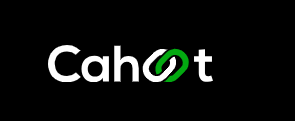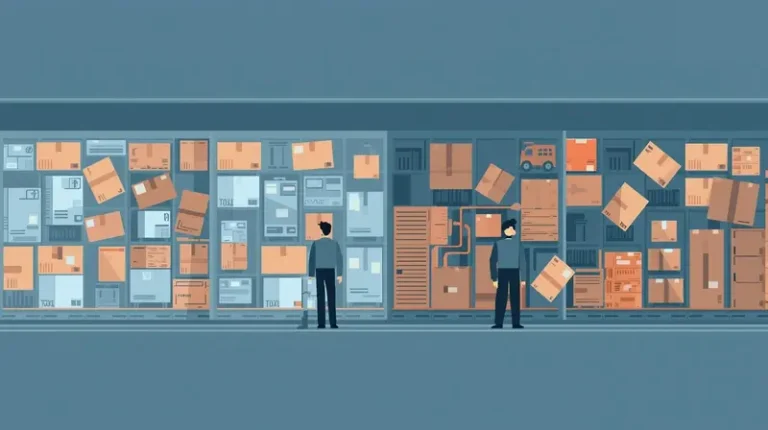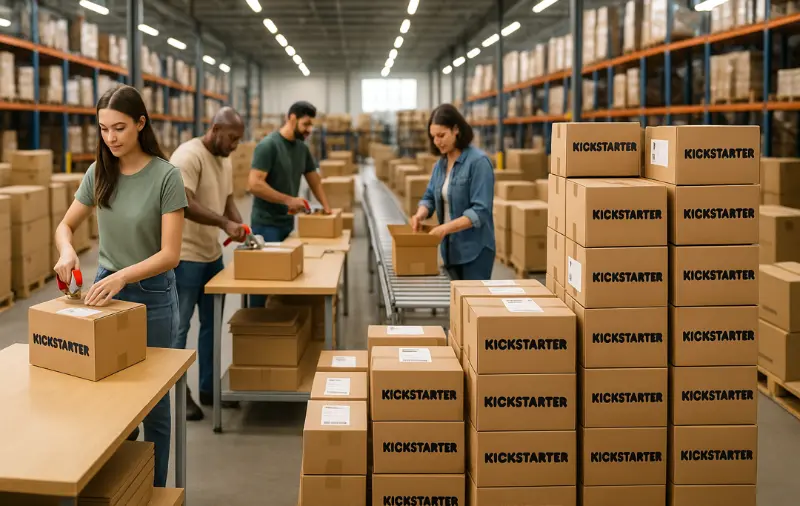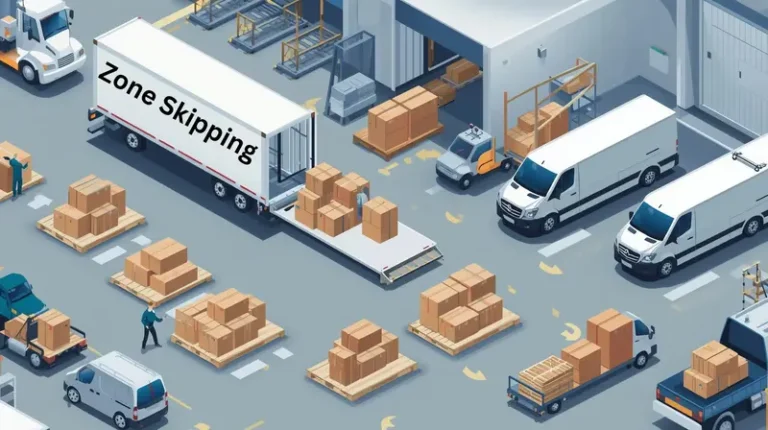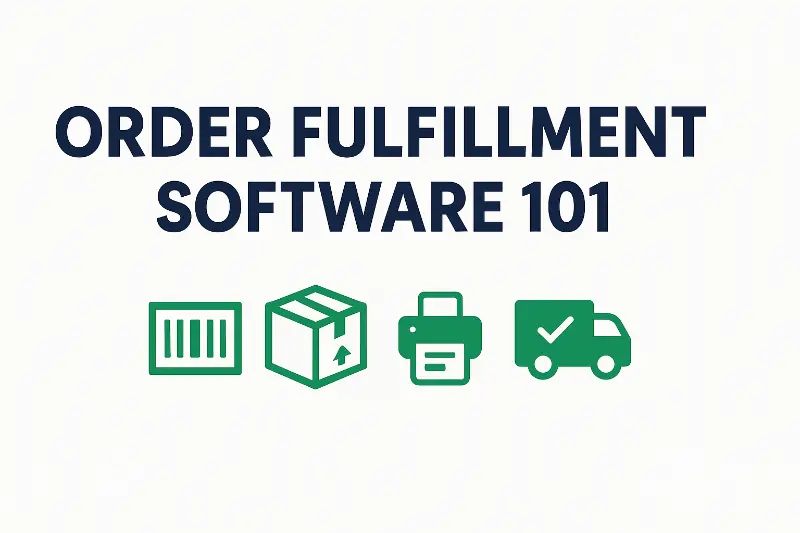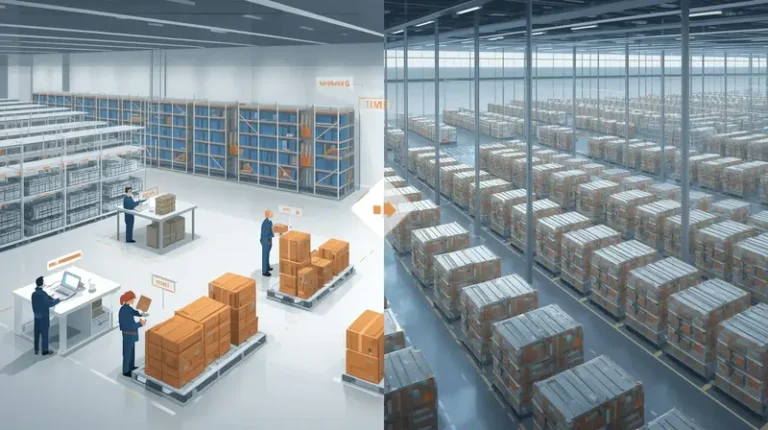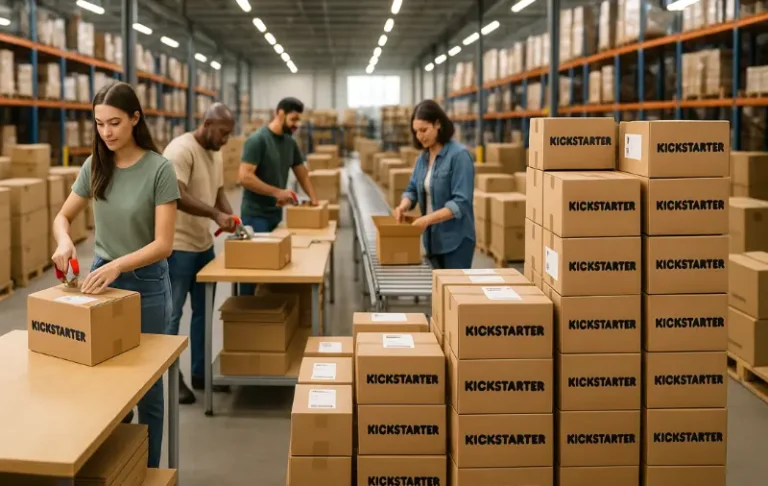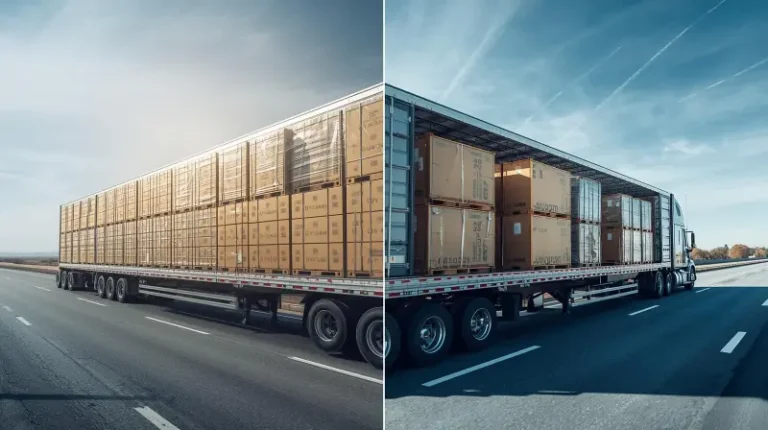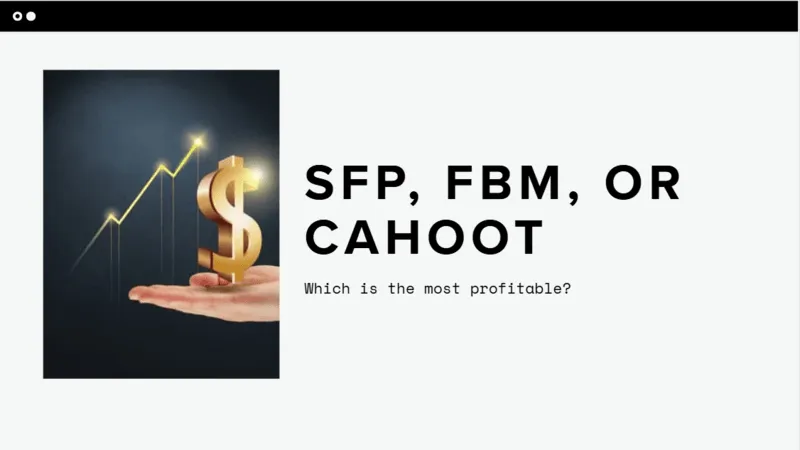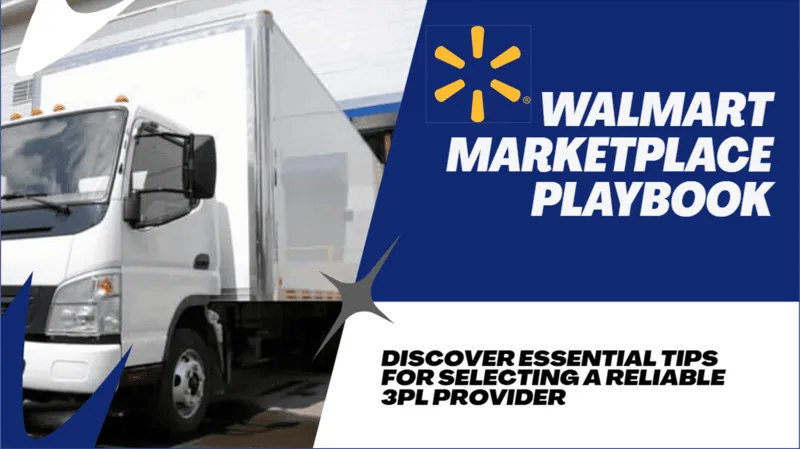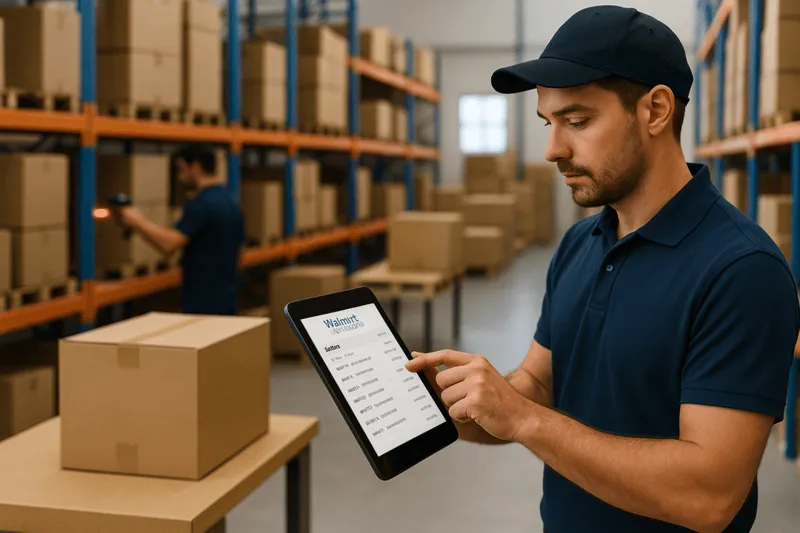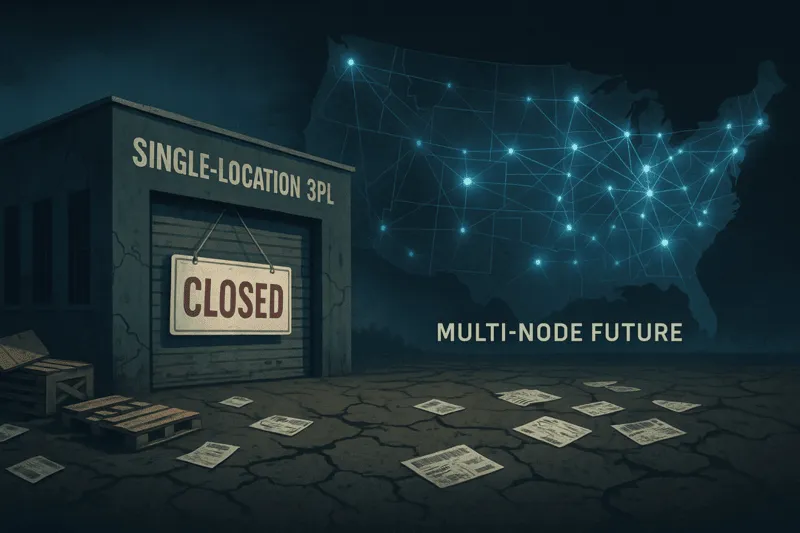Seller Fulfilled Prime vs FBA: The Inventory and Delivery Truth Amazon Doesn’t Fix
In this article
 4 minutes
4 minutes
- FBA’s Prime Delivery Problem: Inventory Placement Gaps
- SFP’s Strict Delivery Standards vs. FBA’s Flexibility
- Inbound Delays and Stockouts: FBA’s Unseen Time Cost
- Returns and Control: FBA’s Lenient Policies vs SFP’s Oversight
- Fee Surprises and Predictability: FBA’s Surcharges vs SFP’s Costs
- The Accountability Asymmetry: Convenience vs Control
- FAQ
Amazon’s Fulfillment by Amazon (FBA) promises Prime convenience, but when one fulfillment center runs out of stock, Prime delivery times can quietly stretch to 4 or 5 days – even if inventory is available elsewhere. In the debate of Seller Fulfilled Prime vs FBA, these are the two main fulfillment options for Amazon sellers, each shaping ecommerce merchants’ order fulfillment and shipping strategies. The uncomfortable truth is that Amazon does not routinely rebalance inventory across warehouses to preserve two-day Prime speeds. Meanwhile, Seller Fulfilled Prime (SFP) holds sellers to strict 1-day and 2-day delivery standards, highlighting a stark accountability asymmetry in how Prime shipping is achieved.
In this article, we’ll break down why FBA’s convenience often trades away control and reliability. We’ll examine how lack of dynamic inventory placement leads to regional Prime delays, how inbound receiving bottlenecks leave sellers waiting with no SLA, and how FBA’s lenient returns and unpredictable fees add hidden costs. By contrast, we’ll see how SFP’s demanding requirements can actually deliver more consistent Prime service through operational control and accountability. If you’re evaluating FBA vs SFP, understanding these differences will help you avoid costly mistakes and choose the fulfillment model that truly meets your delivery reliability and inventory control needs. Becoming an Amazon Prime seller and achieving Prime badge visibility can be a game changer for sales and customer trust.
FBA’s Prime Delivery Problem: Inventory Placement Gaps
Under FBA, Amazon decides where to store your products, and it does not actively redistribute your inventory solely to maintain fast Prime delivery nationwide. Your inventory is stored in Amazon’s fulfillment centers, and merchants incur storage fees for inventory stored there. This can lead to a critical weakness: if one region’s fulfillment center runs out of your item, Amazon won’t automatically move stock from elsewhere in time to cover demand. If inventory is stored too long, you may also face long-term storage penalties. Prime delivery speed quietly degrades, often showing 4–5 day delivery estimates instead of the expected two days.
When One Fulfillment Center Runs Dry (Example)
To illustrate, imagine you sent 100 units to FBA and Amazon stored half in California and half in Illinois. If East Coast customers order after the Illinois stock sells out, orders ship from California – resulting in a 4 or 5-day “Prime” delivery timeframe for a New York buyer.
No Dynamic Rebalancing = Slow Prime in Some Regions
Amazon does not routinely rebalance inventory between fulfillment centers to preserve Prime delivery speeds. This means Prime members can receive slower delivery without seller penalties, often without sellers even realizing it.
SFP’s Strict Delivery Standards vs. FBA’s Flexibility
One of the biggest contrasts in Seller Fulfilled Prime vs FBA is how delivery performance is enforced. SFP sellers are held to exacting standards, while FBA listings can quietly slip to slower delivery times without seller consequences.
Prime Delivery SLAs: One-Day and Two-Day or Else
SFP sellers must meet strict on-time delivery, tracking, and cancellation thresholds or risk losing their Prime badge. Amazon enforces these standards weekly.
Inbound Delays and Stockouts: FBA’s Unseen Time Cost
FBA introduces upstream delays through unpredictable inbound receiving times. Sellers have no SLA and may wait weeks before inventory becomes available for sale.
SFP: Bypass the Check-In Queue
SFP bypasses Amazon’s receiving delays entirely. Inventory is available as soon as it’s on your shelf, giving sellers control and responsiveness.
Looking for a New 3PL? Start with this Free RFP Template
Cut weeks off your selection process. Avoid pitfalls. Get the only 3PL RFP checklist built for ecommerce brands, absolutely free.
Get My Free 3PL RFPReturns and Control: FBA’s Lenient Policies vs SFP’s Oversight
FBA’s return process prioritizes customer convenience, often at the seller’s expense. SFP gives sellers direct control and visibility into returns.
SFP: Hands-On Returns and Brand Protection
With SFP, returns come back to the seller, allowing inspection, recovery, and better brand protection.
Fee Surprises and Predictability: FBA’s Surcharges vs SFP’s Costs
FBA fees are complex and frequently change. SFP costs are more predictable and controllable, though operationally demanding.
The Accountability Asymmetry: Convenience vs Control
FBA offers convenience with less accountability. SFP demands accountability but grants control, predictability, and reliability.
FAQ
Does Amazon rebalance FBA inventory to preserve Prime speed?
No. Amazon does not routinely rebalance inventory between fulfillment centers to preserve two-day Prime delivery.
Turn Returns Into New Revenue
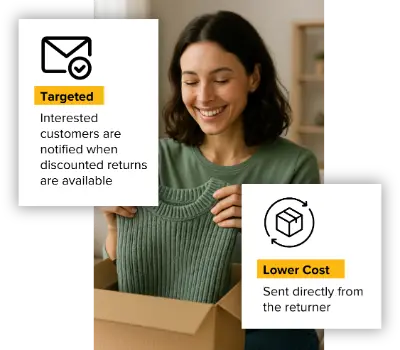
Kickstarter Order Fulfillment: The Complete 2025 Guide
In this article
 13 minutes
13 minutes
Imagine you’ve just had a wildly successful Kickstarter campaign. Funding goal crushed, you did it! But now comes the hard part: Kickstarter order fulfillment; processing and shipping all those Kickstarter orders. Getting all those promised rewards into backers’ hands, on time and intact, is often more daunting than raising the money. It can truly make or break your project’s reputation by meeting backer expectations and ensuring timely deliveries.
Why Fulfillment Can Make or Break Your Kickstarter Campaign
Delivering on your promises is what turns a funded project into a success story. Backers might love your idea, but they’ll judge you by whether you ship their Kickstarter rewards as promised. And many creators struggle here. Roughly 1 in 10 Kickstarter campaigns never deliver the product at all, and among the biggest projects, about 84% ship later than promised. In other words, if you don’t nail your fulfillment process, you risk burning backers’ goodwill even after a great campaign. The entire process of fulfillment, from storage and packaging to shipping and delivery, can be complex and requires careful attention to detail.
Why do creators stumble with order fulfillment? It’s usually because fulfillment is a whole project of its own. Common pitfalls include:
- Bad Planning & Budgeting: Underestimating shipping costs and logistics. Many creators set aside too little money for postage, packaging, and international fees, or don’t anticipate the number of orders in each country. The costs involved, especially for international shipping, customs, and importation, can add up quickly. When reality exceeds expectations, delays and budget overruns hit hard.
- DIY Overload: Trying to fulfill hundreds or thousands of orders by yourself. Creators who insist on boxing and shipping everything solo often face exhaustion, slow deliveries, and mistakes. Past a certain volume, doing it all alone just doesn’t scale; using fulfillment services or fulfillment partners can help avoid burnout and improve efficiency.
- No International Strategy: Shipping to international backers without a plan for customs and duties. Without thorough research and preparation (or help from regional partners), you risk packages getting stuck in customs or paying sky-high rates for overseas delivery.
- Poor Communication: Going silent when fulfillment problems arise. If you don’t keep backers informed about delays or issues, small hiccups turn into big frustrations. Transparent, frequent updates are crucial to maintain trust, and working with the right partner can help maintain communication and avoid surprises.
The good news? With some foresight, you can avoid these pitfalls. It starts with planning your fulfillment early, conducting thorough research, and being ready with the right resources to avoid surprises by preparing early and choosing reliable partners.
Slash Your Fulfillment Costs by Up to 30%
Cut shipping expenses by 30% and boost profit with Cahoot's AI-optimized fulfillment services and modern tech —no overheads and no humans required!
I'm Interested in Saving Time and MoneyPhase 1: Pre-fulfillment Planning
Don’t wait until the last minute to figure out how you’ll ship rewards. Plan your fulfillment strategy as you plan your campaign.
Budget Smartly: Before launch, research shipping options and get cost estimates for various regions. Consider which shipping countries you will support and whether to limit fulfillment to your own country to simplify logistics and reduce costs. Weigh your prototype (with packaging) to calculate accurate postage. Include a healthy buffer in your funding goal for fulfillment expenses; it’s better to raise a little extra than to come up short. When budgeting, account for any setup fees that fulfillment services may charge. Setting realistic shipping fees for backers (or incorporating shipping into pledge levels and reward tiers properly) will prevent surprises later. Plan for handling pre-orders in addition to regular campaign rewards, as this impacts fulfillment planning. Integrating shopping carts with your fulfillment system can streamline order processing and inventory management.
Vet Your Partners Early: Line up reliable manufacturing and shipping partners well before your campaign ends. Whether you plan to fulfill in-house or use a Kickstarter fulfillment partner, start conversations early. Look for partners with experience in the Kickstarter fulfillment process and strong inventory management capabilities. If you’re considering a specialized crowdfunding fulfillment service or 3PL, reach out for quotes and ask about their experience with Kickstarter projects. Early vetting prevents scrambling for a solution after you’ve collected backer money.
Set Realistic Timelines: Be conservative with your promised delivery dates. It’s tempting to say rewards will ship immediately after the campaign, but unexpected delays in production, freight, or customs are common. Build in buffer time. Backers will be much happier if you deliver early than if you announce delays later. Map out each step of the Kickstarter fulfillment process (manufacturing, quality check, freight to warehouse, packaging, shipping) and give yourself some cushion at each stage when you communicate timelines. Make sure to provide up to date information to backers about fulfillment progress.
Phase 2: DIY Fulfillment vs. Fulfillment Partner
Next, decide how you’ll handle the actual shipping of rewards: do it yourself or outsource to a fulfillment service?
Doing It Yourself (DIY): Fulfilling orders on your own can work well for a small campaign. If you have a manageable number of backers (say a few hundred or less) and the time and resources to pack boxes, print shipping labels, and handle post office runs, DIY gives you full control. It can be cost-effective too, you’re not paying service fees to a third party. However, be realistic about the workload. Hundreds of packages can consume weeks of your time. Make sure you have space to store inventory, and perhaps enlist friends or family to help pack. DIY fulfillment is perfectly fine for a successful Kickstarter with modest order counts, but it becomes a strain as volume grows.
Using a Fulfillment Partner: If your campaign has thousands of backers or you’re shipping worldwide, a professional fulfillment partner; more accurately described as a service provider (often a 3PL, third-party logistics company); is worth considering. These service providers handle comprehensive Kickstarter fulfillment work, including storing your inventory in fulfillment centers, picking, packing, and shipping rewards to your backers. 3PLs are experts at fulfilling Kickstarter orders efficiently, managing the entire shipping lifecycle from inventory management to order tracking.
Kickstarter use does not involve a specific shipping company; creators are responsible for selecting their own fulfillment partners or shipping services. The benefits of using multiple warehouses and fulfillment centers are especially important for international campaigns, as they help optimize shipping speed and reduce customs costs. Choosing the right shipping methods is also crucial to ensure timely and cost-effective delivery to your backers.
The obvious downside is cost; you’ll pay for their service, but the upsides include speed, accuracy, and scalability. Good fulfillment companies have systems to handle large volumes efficiently, access to discounted shipping rates, and experience with customs and international shipping. They can often get rewards to your backers faster (and with fewer errors) than you could on your own. For example, if you suddenly have to ship 5,000 packages, a fulfillment partner can accomplish that in days, whereas it might take you weeks. The rule of thumb: if fulfilling orders starts to look like a full-time job, bring in the pros. Just do your homework and choose a partner with Kickstarter fulfillment experience and solid references.
Looking for a New 3PL? Start with this Free RFP Template
Cut weeks off your selection process. Avoid pitfalls. Get the only 3PL RFP checklist built for ecommerce brands, absolutely free.
Get My Free 3PL RFPPhase 3: International Shipping & Backer Management
Shipping rewards globally is a common source of stress for Kickstarter creators. International backers are awesome, but getting a package to a backer in Brazil or Germany isn’t as simple as a domestic shipment. Global shipping introduces additional challenges, such as navigating customs, managing logistics, and ensuring timely delivery across borders. Here’s how to tackle it:
Plan for Customs and Duties: Research the countries where you have backers and understand their import rules. When handling international orders, it’s important to select your shipping countries strategically to streamline costs and avoid customs issues. You may need to fill out customs forms declaring the value and contents of each reward shipment. Decide whether you’ll send packages Delivery Duty Unpaid (DDU), meaning the backer pays any import taxes on arrival, or Delivery Duty Paid (DDP), meaning you collect money upfront and pay the duties so the package arrives with no surprise fees. Many creators choose DDU to keep things simple, but if you do, be sure to warn backers that they’re responsible for any VAT or customs charges. Transparency here will save you many angry emails later.
Consider Local Fulfillment Hubs: If you have a large cluster of backers in a particular region (say Europe or Asia), it might actually be more efficient to bulk ship all those rewards to a local partner and fulfill from within that region. For example, you could send one big shipment to an EU warehouse and have packages forwarded to individual backers from there. This way, those backers get their rewards faster and with lower local postage, and they’re less likely to be charged additional taxes (since intra-EU shipments might avoid certain duties). This approach requires coordination, but it can dramatically improve the experience for international backers and potentially save money on international shipping rates. If you’re considering expanding your reach in the U.S., national fulfillment services can offer similar efficiencies by leveraging a nationwide network of warehouses.
Packaging and Regulations: Different countries have different rules. Some items might face restrictions (for instance, battery-powered devices, food items, liquids, etc.). Work with your shipping partner or do research to ensure your rewards aren’t violating any prohibitions in the destination countries. Also, invest in sturdy custom packaging for international shipments. Branded and personalized packaging not only enhances your brand but also protects fragile items during transit. Managing your supply chain efficiently is crucial for international fulfillment, ensuring your products are manufactured, stored, and shipped in compliance with all regulations. The last thing you want is your product arriving broken after an overseas journey.
Keep Backers Informed: Communication is even more crucial with international backers, because their deliveries take longer and involve more uncertainty. To meet the expectations of most backers, provide tracking numbers for international packages whenever possible. Services like USPS First Class International don’t always offer full tracking, so consider using postal options that do, or regional couriers, even if they cost a bit more. Let backers know when their reward has shipped and give an expected range for delivery (often 2 – 4 weeks for international shipments). Encouraging patience while providing transparency is key.
Phase 4: Keeping Backers Happy Through Fulfillment
Throughout the fulfillment process, remember that your backers are your early supporters and fans. Customer satisfaction should be a key goal at every stage. How you treat them now is crucial for your brand’s long-term reputation. Some tips to keep backers happy (even if you hit a few bumps on the road):
Regular Updates: Don’t go dark after the campaign. Continue to post Kickstarter updates or emails detailing progress, “We received the first batch from the factory,” “All rewards are now packed and awaiting pickup,” etc. Even if nothing has changed, a brief “we’re still on track” update every few weeks reassures backers that you haven’t forgotten them. Lack of information is what breeds frustration.
Honesty About Delays: If you encounter a delay (big or small), inform your backers as soon as you can. Whether it’s a manufacturing issue or shipping vessel stuck at port, share the facts. Backers are usually very understanding about delays when they hear directly and promptly from the creator. What causes anger is silence or vague excuses. It can be tough to admit to problems, but owning it and explaining how you’re addressing it will earn you far more respect.
Customer Service Mindset: Treat every backer inquiry as you would a customer support request. During fulfillment, you’ll get messages: an address needs changing, a package didn’t arrive, a reward came with a defect, etc. Aim to respond quickly and helpfully. For missing or damaged rewards, send replacements if you can (build a small surplus into your production for this). The tone you set in these interactions matters. Satisfied backers are essential for your brand’s reputation and future success. A backer who has an issue resolved promptly can turn into your biggest cheerleader (“they really care!”) whereas an ignored email can turn someone into an unhappy commenter on your project page.
Provide Tracking and Follow-Through: Whenever possible, send out tracking information to backers for their shipments. Many pledge management platforms allow automated emails with tracking numbers. This not only reduces “where is my reward?” questions, but it gives backers peace of mind. Ensuring timely delivery should be a priority; if a tracking shows a package stuck or lost, be proactive, reach out to the carrier or consider re-sending the item. It’s extra effort, but remember, these people believed in you enough to fund you; delivering their reward safely is the least you can do.
Good communication and attentive service throughout fulfillment are the foundation for successful Kickstarter fulfillment. By prioritizing your backers’ experience, you build trust and set your project up for long-term success.
Scale Faster with the World’s First Peer-to-Peer Fulfillment Network
Tap into a nationwide network of high-performance partner warehouses — expand capacity, cut shipping costs, and reach customers 1–2 days faster.
Explore Fulfillment NetworkConclusion / Next Steps
Successfully fulfilling a Kickstarter campaign in 2025 is all about preparation, communication, and choosing the right partners. The same principles apply to all crowdfunding campaigns, whether on Kickstarter, Indiegogo, or other platforms. By baking in a fulfillment plan from the beginning, budgeting properly, and deciding whether to go DIY or use a fulfillment company, you set a strong foundation. From there, focus on international shipping logistics for global backers and maintain great communication throughout.
At the end of the day, smooth Kickstarter fulfillment is a win-win: your backers get what they were promised (and hopefully become repeat customers or brand ambassadors), and you get to cap off your successful campaign with delivered rewards and valuable experience for your next launch. Yes, it’s a daunting task, but if a creator approaches fulfillment with the same passion and thoroughness that they did the campaign itself, it can actually become another opportunity to impress and delight backers.
So plan ahead, take care of the details, and don’t be afraid to ask for help (whether from a 3PL or the Kickstarter community’s advice). With the right approach, you’ll turn your crowdfunding campaign into a fulfillment success story, and that’s the best possible start for whatever you do next.
Frequently Asked Questions
What is Kickstarter order fulfillment?
It’s the process of storing, packing, labeling, and shipping Kickstarter rewards so backers receive what was promised.
How do I handle international shipping?
Use customs forms, clear communication about duties, and consider local fulfillment hubs to reduce costs and delays.
Should I fulfill orders myself or hire a company?
DIY works for small campaigns. Large or global campaigns usually need a fulfillment partner for speed and accuracy.
How can I keep shipping costs low?
Compare carriers early, optimize packaging, use flat-rate or bulk shipping options, partner with services that offer discounts, and consider the best way to ship heavy items to cut costs and maximize profit.
What if my rewards are delayed?
Tell backers quickly, explain why, give a new timeline, and keep them updated until rewards ship.

Turn Returns Into New Revenue

What Is Order Fulfillment Software, And When Do You Actually Need It
If spreadsheets still run your pick lists, you are paying a silent tax. Order fulfillment software turns chaos into routing logic. Businesses of all sizes, from small businesses to large enterprises, can benefit from order fulfillment software.
It decides where to ship from, creates shipping labels automatically, and feeds tracking back to customers and support, improving the customer experience and increasing customer satisfaction. The result: fewer clicks, fewer errors, lower shipping costs.
Using the right technology streamlines the delivery process and helps businesses fulfill orders faster.
Slash Your Fulfillment Costs by Up to 30%
Cut shipping expenses by 30% and boost profit with Cahoot's AI-optimized fulfillment services and modern tech —no overheads and no humans required!
I'm Interested in Saving Time and MoneyPlain English Definition
Order fulfillment software connects sales channels to your logistics operations. It automates the entire fulfillment process from order ingest to warehouse allocation, picking, packing, label creation, and tracking. Order management and order processing are central to the order fulfillment process, ensuring that each step, from receiving a sales order to preparing and shipping the product, is handled efficiently and accurately. Think of it as the brain that routes customer orders to the right fulfillment center and shipping service so you hit delivery times without overspending.
Where people get confused is in the alphabet soup. An OMS manages orders across channels. A WMS runs the inside of a building. Fulfillment software sits in the middle. It knows your inventory levels and shipping preferences, manages sales orders, and streamlines fulfillment operations and processing by deciding which warehouse should fulfill, calling the carrier APIs to print shipping labels, and pushing real-time updates back to your ecommerce platform.
What Good Fulfillment Software Actually Does
- Centralizes orders from all sales channels into a single dashboard with real-time data, low stock alerts, and robust inventory management features. Easily track inventory and monitor stock levels across multiple channels and warehouses.
- Allocates to the best node using rules about delivery times, shipping costs, inventory, and service level.
- Automates labels and documents, including packing slips and customs forms.
- Tracks orders in real time at every stage of the fulfillment process and updates customers automatically through your preferred channels.
- Surfaces exceptions for manual review only where needed, so manual data entry disappears.
- Drives efficiencies by automating and optimizing fulfillment operations, streamlining processes, and maximizing supply chain performance.
When You Truly Need It
You can hustle with one warehouse and one channel. But you actually need a fulfillment solution when any of these tripwires hit.
- Multiple warehouses or strategically located fulfillment centers.
- Two or more major sales channels.
- Delivery speed promises that vary by zone.
- Volume spikes around major sales events that break manual processes.
- Frequent out-of-stocks that require backorder logic and transparent ETAs.
- Handling a high volume of online orders from multiple online retailers.
If two or more are true, stop winging it. The cost of mis-picks, shipping with the wrong carrier, or missing two-day delivery speeds is bigger than the software subscription. Efficient fulfillment operations and a well-integrated supply chain are essential for maintaining customer loyalty as your business grows.
Looking for a New 3PL? Start with this Free RFP Template
Cut weeks off your selection process. Avoid pitfalls. Get the only 3PL RFP checklist built for ecommerce brands, absolutely free.
Get My Free 3PL RFPThe OMS Versus WMS Question You Will Ask
You will ask whether you need an OMS, a WMS, or both. The short answer. OMS orchestrates orders across channels and locations. A WMS runs the inside of a building, handling warehouse management such as inventory control, order processing, and warehouse operations. Many brands run both, with fulfillment software tying them together and talking to carriers. An order fulfillment solution streamlines order processing between OMS and WMS, ensuring efficient and accurate handling of customer orders.
Features That Move The Needle
- Smart routing and rate shopping to reduce shipping costs while meeting delivery expectations.
- Real-time inventory sync and low stock alerts to protect customer trust and avoid overselling.
- Voice picking support to boost pick speed and accuracy up to material levels when paired with a capable WMS.
- Native shipment tracking for real-time shipment tracking and updates after products are shipped.
- Efficiently ship products with confirmation and status updates when orders are shipped, ensuring transparency and timely delivery.
- Audit trails across order details, allocation decisions, and exceptions for informed decisions later.
A Starter Architecture For Small Business To Mid-Market
- Sales channels. Major ecommerce platforms and marketplaces. This architecture is ideal for small businesses looking for scalable and affordable solutions.
- Fulfillment brain. Your order fulfillment software with rules for shipping operations, carrier selection, and SLA guardrails. The software manages sales orders, tracks them through the fulfillment process, and automates the creation of packing slips for each sales order, streamlining order processing and improving accuracy.
- Nodes. One to three fulfillment centers to start.
- Data flow. Single dashboard for real-time insights, full control of shipping labels, and simple returns routing. The system provides visibility into all sales orders, from processing to delivery, helping small businesses monitor and manage orders efficiently.
Cahoot helps small businesses through enterprise clients manage sales orders efficiently and automate packing slip generation. The point is not the brand. It is the design. Choose software that exposes events, automates the label pipeline, and scales to new sales channels without custom projects.
Scale Faster with the World’s First Peer-to-Peer Fulfillment Network
Tap into a nationwide network of high-performance partner warehouses — expand capacity, cut shipping costs, and reach customers 1–2 days faster.
Explore Fulfillment NetworkThe Cahoot View
Cahoot’s software was built to cut shipping costs by routing orders to the closest, best node across our fulfillment partners. This approach drives efficiencies and streamlines fulfillment operations for ecommerce businesses by optimizing order routing, inventory management, and shipping processes. You get one login, a single dashboard, and real-time updates. When your ecommerce business adds multiple warehouses or new sales channels, you do not rewire your store. You flip a switch.
Frequently Asked Questions
How Is Fulfillment Software Different From OMS And WMS?
OMS manages the order lifecycle across channels. WMS manages the warehouse floor. Fulfillment software sits between them to allocate orders and create labels while feeding tracking back to customers.
Will It Actually Reduce Shipping Costs?
Yes, if it routes the order to the closest node and rate shops carriers automatically. Software that cannot rate shop or apply shipping preferences consistently will not move the needle.
Do I Need This With Only One Warehouse?
Not always. But once your business starts to scale, for example, you add more sales channels, add a second node, or promise faster delivery times, manual allocation becomes error-prone and expensive.
How Does Voice Picking Fit?
Voice picking lives inside the WMS. Your fulfillment software should pass clean pick lists to a WMS that supports voice so you gain speed and accuracy benefits.
What Integrations Matter Most?
Direct connections to your ecommerce platform, carriers for labels, and a tracking layer like Cahoot for real-time updates. Without these, your “automation” still depends on manual data entry.

Turn Returns Into New Revenue

Are You Overpaying for Fulfillment? 5 Hidden Fees to Watch
If your 3PL pricing looks fine on the sales deck but ugly on the invoice, you are not alone. Fulfillment fees hide in packing tables, DIM math, “miscellaneous” surcharges, and account management fees that quietly grow. An additional fee for large items, custom packaging, or international shipping can also appear unexpectedly on invoices. Here’s a practical breakdown of the five most common hidden costs in ecommerce fulfillment in 2025, how to spot them, and how to negotiate them out.
1) DIM weight and oversize surprises
Carriers increasingly bill by dimensional weight. UPS lists a divisor of 139 for Daily Rates, and FedEx uses similar guidance; whichever is greater, DIM or actual weight, wins. If your 3PL’s cartonization drifts, you pay more shipping fees than planned. Review carton libraries and require periodic cube audits.
2) Peak and demand surcharges you didn’t model
Expect time-limited holiday price changes and peak surcharges across USPS, UPS, and FedEx this Q4. USPS has already posted its 2025 holiday adjustments, with specific per-package increases by service and zone. FedEx continues to adjust surcharges and recently increased late payment fees to 9.9% of overdue balances. Your 3PL should forecast these into your fulfillment cost model and update your pricing models ahead of peak season.
3) Inbound receiving and special projects that balloon
“Standard receiving” might sound simple, but many third-party logistics providers bill by the hour for complex inbounds, relabeling, or inventory inspection. Setup fees may also apply during the onboarding process, covering initial integration and service setup, and these one-time charges can vary depending on the complexity of your requirements. Typical ranges vary widely, and container handling can also add fees. Insist on service level agreements that define when hourly rates kick in and cap spend per container or inbound receipt.
4) Account management and “program” fees
Some fulfillment providers add a monthly account management line or a “program fee” that doesn’t correlate to measurable value, no SLA, no deliverables. If the fee funds actual logistics operations (dedicated analyst, weekly optimization, custom reporting, support, technology upgrades), great. If not, move to custom pricing where the monthly cost ties to volume or outcomes.
5) Packaging and special handling multipliers
Pick and pack is only part of the story. The packing process, including kitting and assembly, can involve additional steps to meet specific client requirements and may impact overall costs. Boxes, mailers, poly, dunnage, and inserts can add real dollars per order. Ask for pack fees by material type, whether you can bring your own custom-branded packaging, and how “oversize handling” triggers. Publish a packaging bill of materials in your RFP so quotes are comparable. Reference tables from reputable 3PL pricing explainers to benchmark.
Slash Your Fulfillment Costs by Up to 30%
Cut shipping expenses by 30% and boost profit with Cahoot's AI-optimized fulfillment services and modern tech —no overheads and no humans required!
I'm Interested in Saving Time and MoneyFlat Rate Pricing: Is It the Solution to Hidden Fees?
Flat rate pricing has become an attractive option for many ecommerce businesses aiming to simplify their fulfillment costs and avoid the headache of hidden fees. With this pricing model, your fulfillment provider charges a single, fixed shipping cost per order, regardless of the package’s actual weight, dimensions, or destination. For online stores juggling multiple SKUs and fluctuating order volumes, this can make budgeting and cost analysis much more straightforward.
The biggest advantage of flat rate pricing is predictability. Instead of worrying about surprise surcharges, fluctuating shipping rates, or unexpected account management fees, you know exactly what your shipping cost will be for each order. This transparency helps ecommerce businesses avoid hidden costs that often sneak into invoices, like fuel surcharges, residential delivery fees, or delivery area surcharges. By rolling these into a single flat rate, fulfillment providers make it easier to calculate your total fulfillment cost and plan your logistics operations with confidence.
Flat rate pricing can also drive cost savings by streamlining your fulfillment process. With fewer variables to track, your team spends less time calculating shipping costs and more time focusing on inventory management, optimizing storage space, and improving customer experience. Many fulfillment services that offer flat rate pricing also bundle in warehousing fees, packaging materials, and even custom packaging options, further reducing the risk of additional fees cropping up later.
However, flat rate pricing isn’t a one-size-fits-all solution. If your ecommerce business regularly ships large, heavy, or unusually shaped items, a flat rate may not reflect your actual shipping cost, and you could end up paying more than you would with a customized pricing model. Flat rate pricing also tends to be less flexible than tiered or weight-based pricing models, which can be adjusted as your order volume or shipping needs change. For some businesses, especially those with highly variable shipments, a more tailored fulfillment strategy may deliver better cost savings.
When evaluating flat rate pricing, consider how it impacts your warehousing costs and inventory management. Some fulfillment providers include storage fees in their flat rate, while others charge separately based on the amount of storage space your inventory occupies. Make sure you understand exactly what’s included in the flat rate and how it aligns with your business operations.
How To Calculate Your Total Fulfillment Cost
- Order fulfillment: The order fulfillment process includes receiving inventory, storage, picking, packing, and shipping, with each stage contributing to the overall cost.
- All-in per order: pick fee + additional picks + packaging + shipping label + surcharges + storage amortized + returns share + account management fees + pick and pack fee + labor costs.
- Storage: rate per storage space unit (bin, shelf, pallet, cubic foot) plus any long-term or specialized storage lines; model seasonal inventory peaks. Storage costs can be calculated as a fixed fee or flat rate, and storage fees may vary depending on space utilization and duration.
- Inbound: receiving method (per pallet, per carton, hourly), labeling, and non-compliance penalties. Inbound shipping is also a cost factor when sending inventory to fulfillment centers.
- Reverse logistics: expected return rate and per-unit processing cost.
- Shipping rates: lane-level quotes for your top SKUs and destinations; ensure major carriers and regionals are included with negotiated shipping rates. Shipping carriers and pick and pack fees can vary depending on the provider and order volume.
Cost structures for fulfillment companies and fulfillment partners can vary depending on the provider, and many fulfillment providers offer customized solutions for online stores to achieve lower costs and total cost transparency.
Fulfillment centers and fulfillment companies may use standard packing materials, but higher costs can result from special handling or hazardous materials.
Outsourcing logistics to a third-party logistics (3PL) provider can help achieve cost savings and optimize the supply chain.
It is important to compare total costs, including all fulfillment costs across providers, and all fees, to avoid surprises.
Looking for a New 3PL? Start with this Free RFP Template
Cut weeks off your selection process. Avoid pitfalls. Get the only 3PL RFP checklist built for ecommerce brands, absolutely free.
Get My Free 3PL RFPNegotiation Scripts That Work
- “Cap my hourly.” If hourly receiving is unavoidable, cap hours per inbound and include auto-approval thresholds.
- “Publish the pack BOM.” Fix the unit price of each packaging material item for 6 – 12 months.
- “Show me DIM control.” Quarterly cartonization audit with sample orders and photos, or fee credits.
- “Outcome-based account management.” Tie the monthly fee to specific deliverables and SLA improvements, not a vague “program.”
Where Cahoot Saves Money By Design
- Bulk purchasing power on materials across our network reduces pack fees.
- Cartonization and rate-shop automation curb DIM surprises.
- Multi-node placement reduces zones, so you pay ground, not air.
- Transparent invoices with line-item detail keep you in control.
Frequently Asked Questions
What is the right DIM divisor to use in 2025?
UPS lists 139 for Daily Rates, and FedEx applies dimensional weight rules with similar divisors. Always check current carrier guides; your divisor may vary by service.
Will there be 2025 holiday surcharges?
Yes. USPS has posted time-limited holiday increases for October 2025 – January 2026, and FedEx/UPS maintains demand surcharge frameworks. Model these in your fulfillment pricing now.
Are account management fees normal?
They exist, but should buy value, analytics, continuous improvement, and SLA oversight. If you cannot tie the line to outcomes, negotiate it out, or convert to custom pricing.
How do I compare 3PL quotes apples to apples?
Normalize to an all-in fulfillment cost per top SKU and destination: storage, picks, pack materials, label, surcharges, and returns. Use an identical packaging bill of materials for all bidders.
How does Cahoot help me avoid hidden costs?
We quote transparently, automate rate-shopping and cartonization, and place inventory near demand to lower logistics costs while meeting customer expectations on shipping speed.

Turn Returns Into New Revenue

How to Choose a 3PL for Pet Products: Temperature, Turnaround, and Trust
In this article
 9 minutes
9 minutes
- Why Pet Is Different
- The Three T’s: Temperature, Turnaround, Trust
- Sustainability and Environmental Responsibility
- Technology And Innovation In Pet Product Fulfillment
- Risk Management And Mitigation
- The Pet 3PL Checklist (Copy/Paste To Your RFP)
- Inventory Management Strategy For Pet Brands
- How Cahoot Helps Pet Brands Win
- Frequently Asked Questions
Pet customers are loyal, vocal, and absolutely unforgiving when order fulfillment goes sideways. If the food arrives warm, the treats crumble, or the litter leaks, they do not reorder. That is why choosing a 3PL for pet products is less about cheap storage and more about temperature control, effective inventory management, and spotless compliance. The pet industry sets unique standards for logistics, requiring specialized solutions to meet regulatory requirements and the growing demands of pet owners. A pet products business must also ensure that high-quality products reach customers, maintaining quality assurance and safety throughout the supply chain. You also need to make sure your 3PL can meet the demanding performance metrics for your channels, such as Chewy Marketplace, for example.
Why Pet Is Different
Pet isn’t “just another CPG.” Dry pet food needs cool, dry storage, typically under 80°F; moisture swings and heat degrade nutrients and oil stability. Wet food and fresh formulas add temperature-controlled storage and stricter handling. These aren’t nice-to-haves; they’re FDA-anchored realities under the Food Safety Modernization Act’s (FSMA) Preventive Controls for Animal Food and related guidance.
Beyond the FDA, labels and handling instructions often follow the Association of American Feed Control Officials (AAFCO) model guidance, storage directions, ingredient statements, and clarity on life-stage. Your 3PL must respect those labels and keep documentation on hand for audits. To ensure compliance with all relevant regulations, it is essential to follow proper procedures throughout the supply chain. Careful handling and precise handling of pet products are critical to maintain product quality and safety during storage, packing, and transportation.
Meanwhile, demand is resilient. U.S. pet spending reached about $152 billion in 2024 and is projected to hit roughly $157 billion in 2025. That means opportunity for brands that safeguard product safety and customer loyalty with reliable shipping and delivery speed.
Slash Your Fulfillment Costs by Up to 30%
Cut shipping expenses by 30% and boost profit with Cahoot's AI-optimized fulfillment services and modern tech —no overheads and no humans required!
I'm Interested in Saving Time and MoneyThe Three T’s: Temperature, Turnaround, Trust
Temperature. Your 3PL should provide documented temperature and humidity controls for dry, canned, and fresh categories, with sensor logs you can audit. For fresh and refrigerated diets, verify the cold chain plan, from dock to reliable carriers to the final destination.
Turnaround. Pet shoppers reorder frequently, often on a weekly cadence. That means consistent same-day pick, accurate inventory management strategies, and backup labels when carriers miss pickups. Efficient order processing and expertise in fulfilling orders are essential to achieve accurate delivery and meet customer expectations. The metric that matters is SLA adherence across seasonal demand, not the one perfect day.
Trust. Trust equals compliance plus transparency. You need FSMA Part 507 awareness (sanitation, pest control, recall readiness) and clean warehouse management system records. Ask for mock recall drill results and how quickly they can isolate lots by stock levels and real-time inventory tracking. Real-time visibility in pet care fulfillment ensures customers can track their orders and builds trust in your brand.
Sustainability and Environmental Responsibility
Sustainability is no longer optional in the pet products industry; it’s a core expectation from both pet owners and retail partners. The environmental impact of pet supplies fulfillment, from packaging waste to carbon emissions, is under increasing scrutiny. Leading 3PLs are stepping up by offering eco-friendly packaging options, such as biodegradable bags and recyclable materials, that help reduce landfill waste without compromising product safety. Optimizing shipping routes and consolidating orders can further cut down on carbon emissions, making the entire supply chain more efficient and environmentally responsible.
Energy-efficient warehouse operations, like LED lighting and smart climate controls, not only lower the carbon footprint but also contribute to cost savings for pet products businesses. Waste reduction programs, including recycling initiatives and responsible disposal of damaged goods, help ensure that every step of the fulfillment process aligns with sustainability goals. By choosing a 3PL that prioritizes environmental responsibility, pet products businesses can strengthen their brand reputation, meet evolving market demands, and deliver the level of customer satisfaction today’s eco-conscious consumers expect.
Technology And Innovation In Pet Product Fulfillment
Technology is transforming the way pet products businesses manage inventory, fulfill orders, and meet customer expectations. A modern warehouse management system (WMS) is the backbone of efficient pet products fulfillment, providing real-time tracking of inventory, optimizing stock levels, and ensuring accurate order fulfillment. Automated packaging and labeling systems streamline the fulfillment process, reducing errors and speeding up operations, key to meeting the fast turnaround times pet owners demand.
Advanced solutions like AI-powered inventory forecasting and predictive analytics allow pet products businesses to anticipate seasonal demands and unexpected market changes, minimizing missed sales opportunities and excess stock. These tailored solutions not only improve inventory accuracy but also drive cost savings and timely delivery across every sales channel. By leveraging the latest technology, 3PL providers can offer scalable, efficient operations that keep pet products businesses ahead of the curve and ensure a positive customer experience from click to doorstep.
Looking for a New 3PL? Start with this Free RFP Template
Cut weeks off your selection process. Avoid pitfalls. Get the only 3PL RFP checklist built for ecommerce brands, absolutely free.
Get My Free 3PL RFPRisk Management And Mitigation
Risk is a constant in the pet products industry, whether it’s a product recall, supply chain disruption, or regulatory change. Effective risk management is essential for protecting your brand and maintaining customer loyalty. A 3PL with deep experience in the pet products industry will proactively identify potential risks, from inventory shortages to compliance gaps, and develop contingency plans to keep your supply chain resilient.
This means implementing strict quality control measures, maintaining transparent pricing, and ensuring regulatory compliance at every stage of the fulfillment process. Real-time inventory tracking and regular audits help prevent missed sales opportunities and reduce unnecessary labor or capital expenditures. Ongoing training and inspections ensure that every team member is prepared to handle unexpected challenges, safeguarding both product integrity and customer experience. By partnering with a 3PL that prioritizes risk management, pet products businesses can confidently scale operations, protect their reputation, and deliver the reliable service that keeps pet owners coming back.
The Pet 3PL Checklist (Copy/Paste To Your RFP)
- Storage specs per SKU: dry kibble below 80°F, moisture control, separation from cleaners and chemicals.
- Lot and expiration control with FEFO (First Expired, First Out), plus expired inventory quarantine procedures.
- Pest management plan aligned to Part 507 GMPs, with logs.
- Dock-to-door cold chain validation for refrigerated or frozen lines.
- Carrier matrix that matches the weight and cube of bulk pet food and grooming supplies; not every lane is UPS Ground.
- Packaging SOPs: protective packaging for cans and glass, poly-in-box for oils, liners for dusty litter SKUs.
- Returns triage: when to destroy vs restock to protect pet health.
- Transparent pricing: no mystery “food handling” fee; itemized fulfillment services, hidden fees called out.
- Recall readiness: mock recall completed in the last 12 months; time to isolate all affected lots.
- Data access: real-time inventory, aging, and real-time tracking through your OMS.
- Customized solutions: ensure the 3PL can provide customized solutions for different pet products, including specialized warehousing and packaging as needed.
- Pet products fulfillment strategy: confirm there is a robust pet products fulfillment strategy in place to address product handling, inventory accuracy, and timely delivery.
- Managing inventory: prioritize effective systems for managing inventory, including forecasting and coordination to avoid stockouts or overstock.
- Outsourced pet products fulfillment: consider the benefits of outsourced pet products fulfillment for efficiency, scalability, and proper handling of industry-specific requirements.
Scale Faster with the World’s First Peer-to-Peer Fulfillment Network
Tap into a nationwide network of high-performance partner warehouses — expand capacity, cut shipping costs, and reach customers 1–2 days faster.
Explore Fulfillment NetworkInventory Management Strategy For Pet Brands
- Pet brands often experience seasonal demands, requiring them to adapt their inventory strategies to handle fluctuations in order volume and product mix.
- Segment storage by risk and velocity. Keep fast movers close to carriers, slow movers deeper in the building to save warehouse space.
- Efficient management of pet supply, including pet food, treats, and health items, is crucial, especially when segmenting inventory to ensure timely fulfillment and compliance.
- Forecast by reorder cadence. Autoship means steady rhythm with occasional spikes; tune labor and slots accordingly.
- Leveraging outsourced pet products services can help brands handle inventory fluctuations and scale operations up or down as needed.
- Smaller shipments to test new flavors or bag sizes, then ramp. This reduces missed sales opportunities and obsolescence.
- Dual-node setup for national coverage, so your customers expect 1 – 2 day delivery without air. That is pure cost savings.
- Risk management: diversify suppliers, pre-approve alternates, and lock in packaging conversions well before unexpected market changes.
How Cahoot Helps Pet Brands Win
We run pet-friendly SOPs: temp monitoring for dry zones, FEFO allocations, protective pack recipes for cans and fragile jars, and scalable solutions across our network of distribution centers. We provide personalized service and tailored fulfillment solutions for pet brands, ensuring expert handling of diverse products like pet beds and other pet essentials. Add multi-node routing to keep timely delivery and on-time delivery consistent without paying for air. And because we operate as a transparent fulfillment partner, our transparent pricing lets you see the true landed cost per order.
Frequently Asked Questions
What regulations apply to pet food storage in 3PLs?
FSMA’s Preventive Controls for Animal Food and 21 CFR Part 507 require GMPs, sanitation, pest control, and records for facilities that manufacture, process, pack, or hold animal food. Your 3PL must comply.
Do dry kibble products really need temperature control?
Yes. FDA and AAFCO guidance recommend keeping dry food under about 80°F, away from moisture and heat, to maintain nutrient integrity and shelf life.
How fast should a pet 3PL ship?
Same-day fulfillment for orders before cutoff and predictable 1–3 day ground delivery for most ZIPs. Reliability matters more than a single headline speed.
How do pet products 3PLs handle recalls and lot tracking?
Insist on lot-level granularity, FEFO, and a proven mock recall. The 3PL should be able to locate, quarantine, and report affected inventory within hours.
How does Cahoot reduce pet fulfillment costs?
By placing inventory near demand, optimizing cartons, and using regional carriers for heavy items, we cut shipping costs while maintaining customer satisfaction and brand loyalty.

Turn Returns Into New Revenue

Amazon SFP: Profit Math, Pitfalls, and the Smarter Alternative
In this article
 7 minutes
7 minutes
- What SFP Actually Demands For The Prime Badge In 2025
- The Hidden SFP Shipping Costs Stack
- SFP vs FBM vs Cahoot: The Margin View
- A Simple Seller Fulfilled Prime Program Decision Tree
- Three Operational Truths Nobody Tells You
- How To Win With Prime Customers, Whether You Choose SFP Or Not
- Frequently Asked Questions
Short answer, yes, Seller Fulfilled Prime can work in 2025. As part of the broader Amazon Prime program, Seller Fulfilled Prime (SFP) is a fulfillment option that allows third-party sellers to fulfill Prime orders directly from their own warehouses. Here’s how Seller Fulfilled Prime works: sellers manage their own inventory and shipping, but still offer customers the Prime badge, fast free delivery, and a premium experience, without using Amazon’s FBA warehouses. This approach can help sellers reach Prime customers, control storage costs, and enhance brand recognition.
Longer answer, it depends on whether you can hit strict speed, coverage, and quality metrics while keeping shipping costs from eating your margin. The 2025 refresh tightened rules again, added weekend coverage checks, and introduced volume floors. Ultimately, the decision to use SFP should be based on your business model and your ability to meet the program’s requirements.
Slash Your Fulfillment Costs by Up to 30%
Cut shipping expenses by 30% and boost profit with Cahoot's AI-optimized fulfillment services and modern tech —no overheads and no humans required!
I'm Interested in Saving Time and MoneyWhat SFP Actually Demands For The Prime Badge In 2025
To join SFP, sellers must have a professional selling account to enroll in Seller Fulfilled Prime. Sellers must pre-qualify, then pass a 30-day seller fulfilled prime trial, also referred to as the prime trial, trial period, or prime trial period. During this phase, sellers must fulfill a certain number of prime trial orders and meet strict performance metrics: at least 93.5% on-time delivery, 99% valid tracking, ≤0.5% seller-initiated cancellations, and a steady baseline of 100 Prime packages per month after enrollment. Sellers must also have a default shipping address in the US to enroll in seller fulfilled prime. Weekend operations are monitored, and Prime offers must cover the contiguous U.S. with competitive two-day delivery speeds where feasible.
Sellers must meet all seller fulfilled prime requirements and prime requirements to maintain eligibility in the program. As part of the enrollment and management process, sellers configure shipping settings in Seller Central to ensure compliance with Prime standards. Successful completion of the trial allows sellers to gain access to Prime customers and the Prime badge, increasing product visibility and sales potential.
Amazon has also announced 2025 program updates (effective late June) impacting SFP and Premium Shipping, including policy clarifications and protections when Amazon sets promises and you ship on time using eligible labels. Great when it applies, but you still own the ops.
The Hidden SFP Shipping Costs Stack
SFP’s trap is simple. You keep inventory in your own warehouse or with a third-party logistics provider, you display the Prime badge, and you own the fulfillment process. Having sufficient fulfillment capacity is crucial for meeting the strict requirements of the Seller Fulfilled Prime program. Amazon sellers and third-party sellers can fulfill orders themselves or partner with third-party logistics providers to handle shipping and storage. Miss a weekend pickup, mis-estimate a lane, or under-optimize cartons, and your Prime orders get expensive fast. Fulfilling orders efficiently is critical for maintaining Prime status and being a successful Prime seller. Enrolled in Seller Fulfilled Prime, sellers can make Seller Fulfilled Prime offers and must ensure they are offering free shipping, which is a key benefit for customers and a requirement for SFP. Maintaining Prime status requires ongoing compliance with program standards.
- Weekend staffing: You must operate at least one weekend day and use shipping services with weekend pickup/delivery coverage.
- Nationwide promise pressure: Standard nationwide shipping for all Prime offers, plus competitive 1–2 day promise exposure in many ZIPs.
- Order-limit throttling: If you don’t maintain volume and speed, Amazon can clamp your daily Prime order limit until you recover. (Commonly cited by program trackers.)
In other words, SFP is feasible when you have multi-node coverage, tight inventory management, and smart routing. Both third-party Amazon sellers and Amazon sellers can choose between FBA, FBM, and the Seller Fulfilled Prime program depending on their business needs. If not, Fulfillment by Amazon (FBA) or FBM + Cahoot may deliver better customer satisfaction and profit.
Looking for a New 3PL? Start with this Free RFP Template
Cut weeks off your selection process. Avoid pitfalls. Get the only 3PL RFP checklist built for ecommerce brands, absolutely free.
Get My Free 3PL RFPSFP vs FBM vs Cahoot: The Margin View
FBM vs FBA gives you control and lower platform fees, but you lose the Prime badge and must maintain reliable delivery standards for your sales channels. FBM operates through the merchant fulfilled network, where sellers handle storage, packing, and shipping themselves, taking on full responsibility for logistics and customer service. FBA buys you Prime eligibility and leverages Amazon’s fulfillment centers, large warehouses where Amazon stores your inventory, manages packing, shipping, and customer service, streamlining the process and boosting sales potential, though storage and handling fees can be painful for slow-moving or oversized SKUs. SFP sits in the middle, delivering the Prime badge with your own ops, but only if you can truly run a Prime-class network. Market watchers note that overall Amazon competition has eased from 2021 highs, which helps conversion if you can deliver fast and free shipping reliably.
Where Cahoot fits: we turn FBM into something closer to SFP economics by routing to the best node and carrier for each order, including weekends, so your on-time delivery and valid tracking rate can match SFP expectations without carrying SFP’s strict nationwide promise liability yourself.
A Simple Seller Fulfilled Prime Program Decision Tree
- Under 2 lb, high-velocity, small parcel, steady volume ≥100 Prime orders/month? Consider SFP, but only with multi-node and weekend ops.
- Oversize, seasonal, or irregular demand? FBA or FBM + Cahoot.
- Multi-channel beyond Amazon (Walmart, Shopify, eBay)? SFP adds complexity with thin payoff; FBM + Cahoot preserves control.
Three Operational Truths Nobody Tells You
1. Weekend promise math is unforgiving. Your shipping template, carrier weekend capabilities, and pickup windows must align. If the template shows Saturday pickup, non-Prime orders in that template often inherit weekend obligations too, and some orders may require same-day shipping to meet Prime and SFP requirements. Plan staffing and cutoffs accordingly.
2. Prime shipping templates are critical for SFP. Setting up a Prime shipping template in Seller Central is essential to qualify for Prime orders and optimize costs. Configuring shipping templates properly enables Prime shipping and ensures you meet required shipping speed and delivery speed metrics for Seller Fulfilled Prime. When fulfilling orders, use shipping labels purchased through Amazon Buy Shipping Services to streamline order fulfillment, shipment tracking, and reliable delivery through Amazon’s trusted network.
3. Nationwide coverage isn’t optional. Even for standard shipping, SFP requires contiguous U.S. coverage. If your single node sits on the coast, your cost to keep 1 and 2-day exposure jumps.
Scale Faster with the World’s First Peer-to-Peer Fulfillment Network
Tap into a nationwide network of high-performance partner warehouses — expand capacity, cut shipping costs, and reach customers 1–2 days faster.
Explore Fulfillment NetworkHow To Win With Prime Customers, Whether You Choose SFP Or Not
- Build weekend operating muscle with clear cutoffs and carrier mix.
- Add nodes or enable peer-to-peer fulfillment to collapse zones.
- Automate cartonization and rate-shop every label.
- Set conservative daily caps so you don’t over-promise on major sales events.
- Optimize your Prime listings to increase visibility, display the Prime badge, and boost conversions.
- Align your operations to reflect Prime customers expectations, ensuring your service levels and delivery quality meet what Prime customers anticipate.
- Leverage SFP to deliver directly to domestic Prime customers from your own warehouse, enhancing brand recognition and customer satisfaction.
- Use Cahoot to meet Prime customers’ expectations without locking into SFP for every SKU.
Frequently Asked Questions
What are the 2025 SFP performance requirements?
Expect 93.5% on-time delivery, 99% valid tracking, ≤0.5 percent seller-initiated cancellations, weekend operations, and steady volume of at least 100 Prime packages per month post-enrollment.
Do I have to ship on weekends for SFP?
Yes. SFP policies require weekend operations, plus carriers that support weekend pickup and delivery. Templates and coverage must match your actual capability.
Is SFP cheaper than FBA?
Depends on your cube, weight, and geography. SFP can be cheaper for compact, fast-moving SKUs when you run multi-node fulfillment. For bulky or slow movers, FBM + Cahoot or selective FBA often wins.
What’s new in the 2025 SFP rules?
Amazon issued program updates and clarified protections when promises are Amazon-set and you ship on time with eligible labels. There are also policy refreshes effective June 29, 2025.
How does Cahoot help with SFP, FBM, and FBA?
We route every order to the fastest, cheapest compliant path, maintain weekend coverage with regional carriers, and provide the inventory management and fulfillment partner capabilities you need to protect metrics and margin.

Turn Returns Into New Revenue

Walmart 3PL Success: Why Most 3PLs Don’t Support Walmart Properly (And How to Vet Them)
If you sell on Walmart Marketplace, your 3PL can make or break your growth. Selling on Walmart Marketplace gives you the opportunity to reach millions of customers, expanding your potential audience significantly. The platform is surging, the buyers are trained on fast delivery, and Walmart’s physical stores quietly turbocharge the last mile. Most third-party logistics providers still operate with an “Amazon-only” mindset. That’s why so many Walmart orders get stuck, misrated, or delayed.
Here’s the playbook I use to evaluate a Walmart 3PL, so you get the upside of Walmart Fulfillment Services, cost savings on shipping, and a better customer experience without surprise hidden fees.
Slash Your Fulfillment Costs by Up to 30%
Cut shipping expenses by 30% and boost profit with Cahoot's AI-optimized fulfillment services and modern tech —no overheads and no humans required!
I'm Interested in Saving Time and MoneyWalmart Marketplace Is A Different Animal
Walmart’s Marketplace isn’t a niche anymore. Seller count and volume have accelerated through 2025, with Marketplace Pulse tracking a 30 percent increase in sellers in the first five months alone and a rapid influx of international sellers. Translation, more competition, and a higher bar for fast delivery and customer expectations.
And Walmart keeps leaning into its superpower, stores. The company extended delivery coverage to 12 million more households in 2025 using geospatial routing, letting multiple Walmart stores fulfill a single order. That store network, rebranded as Accelerated Pickup and Delivery (APD), turns physical stores into fulfillment centers for real-time speed. Walmart fulfillment centers and warehouses are strategically located to enable fast delivery and efficient inventory management. These Walmart fulfillment centers and warehouses play a key role in storing products and supporting the fulfillment center network. Effective warehousing and storing inventory are essential for meeting Walmart’s delivery expectations and ensuring accurate, timely order fulfillment.
If your 3PL can’t plug into that ecosystem, or at least align to its service levels, your Walmart orders will lag.
Why Most 3PLs Miss The Mark On Walmart
1. They copy-paste Amazon SOPs. Routing rules, order management systems, and fulfillment process logic often assume Amazon’s cutoffs and zones. Walmart’s promise logic is different, and Walmart fulfillment windows require different carriers, shipping costs math, and cubic foot handling. If your 3PL doesn’t tune templates for Walmart, you eat hidden costs and miss same-day shipping promises. Understanding Walmart’s requirements is essential for 3PL success, as optimizing your supply chain and ensuring compliance are key to smooth operations. When evaluating a third-party logistics (3PL) provider, consider key factors like lead times, return processes, and pricing to ensure efficient order management and customer satisfaction. Choosing the right fulfillment partner can be a game-changer for Walmart sellers, enabling you to deliver products reliably and on time, and taking advantage of advanced 3PL services and technology can further optimize your operations.
2. They don’t model store-adjacent speed. Walmart’s network reduces zones for last-mile lanes. Your 3PL should steer Walmart Marketplace sellers toward regional carriers or local injection that mirrors APD pace, not default to national major carriers every time. Recent data shows Walmart customers leaned heavily into same-day during summer deal weeks, because stores are everywhere. When it comes to delivering orders quickly, fulfillment speed is critical; your 3PL must be capable of delivering orders quickly to meet customer expectations and ensure they are delivered accurately.
Looking for a New 3PL? Start with this Free RFP Template
Cut weeks off your selection process. Avoid pitfalls. Get the only 3PL RFP checklist built for ecommerce brands, absolutely free.
Get My Free 3PL RFP3. They skip WFS knowledge. Even if you don’t use Walmart Fulfillment Services (WFS), your 3PL should know the program’s fulfillment fees, storage rules, hazmat items policies, and routing guide, because those benchmarks anchor buyer expectations, and they’re often cheaper than you think. As of April–July 2025, Walmart publicized that WFS averages about 15 percent less than “the competition” with clear storage/optional fee tables and peak windows. Testing shipments with your 3PL before full rollout is important for quality and compliance, and helps ensure smooth scaling of your operations.
4. They don’t support Walmart-specific data flows. You need real-time tracking in Seller Center, clean inbound receiving for fulfillment centers, and order processing events that match Walmart’s performance scorecards. A 3PL that can’t expose these events reliably will ding your customer satisfaction and rank. It is also important to promptly mark orders as shipped once they are dispatched, maintaining transparency and trust with your customers.
5. They hide fees. Watch for “Walmart handling” surcharges, unexpected packaging materials fees, and shipping weight upcharges for large cube items. If you can’t audit fulfillment fees per order, you can’t scale. For large or bulk items, having freight options is essential to ensure efficient and cost-effective shipping.
The 12-Point Walmart 3pl Vetting Checklist
1. Native Walmart integration, not a connector-of-a-connector. Test order create, cancel, ship confirm, returns, and real-time tracking.
2. Walmart promises parity. Can they meet WFS-like SLAs on 1 – 2 days to core zip clusters, and do they simulate Walmart’s promise windows before you publish offers?
3. Regional carrier bench. Ask for their on-time performance across Zones 5 – 8 for your top five lanes. If they only quote national carriers, expect higher shipping costs.
4. Store-adjacent injection. Do they support scheduled late pickups or local injection to mirror APD speed near key Walmart stores?
5. Dim and cube handling. Walmart’s heavy and oversize rules differ; ensure cartonization and cubic foot billing are transparent.
6. Peak season plan. Can they surge headcount and dock space for peak season without “capacity caps”? Get last Q4’s throughput.
7. Hazmat and temperature control. If you sell aerosols or meltables, confirm temperature control zones and hazmat credentialing.
8. Returns and reverse logistics. How fast can they receive, grade, and restock?
9. Value-added services. Kitting, relabels, packaging materials swaps, and order management exceptions.
10. Inventory management maturity. Cycle counting, shrink reporting, and slotting tuned for your top SKUs.
11. Transparent pricing. Line-item fulfillment services by pick, pack, dunnage, storage; no “Walmart” surcharge.
12. Case studies on Walmart. Ask for references from marketplace sellers with your weight and cube profile.
Scale Faster with the World’s First Peer-to-Peer Fulfillment Network
Tap into a nationwide network of high-performance partner warehouses — expand capacity, cut shipping costs, and reach customers 1–2 days faster.
Explore Fulfillment NetworkWhen To Mix WFS And A 3PL
WFS is compelling, especially for fast movers that fit the fee table. You still need a third-party logistics partner for multichannel work, oversized items, or SKUs that perform better outside WFS. WFS publishes current pricing, optional services, and routing guides. Use those to set target service levels for your 3PL.
A hybrid model works: let WFS carry your highest-velocity Walmart SKUs, and use a vetted Walmart 3PL for the long tail and multi-channel orders (Shopify, DTC, marketplaces). Walmart has also been investing in seller services and embedded finance to speed payouts, another reason volume is migrating. Your 3PL should be ready to ride that wave, not fight it.
Practical Takeaways
- Treat Walmart like Walmart, not Amazon. Different promise logic, different network, different fulfillment solutions.
- Build a carrier mix that prefers short zones and regional speed.
- Benchmark against WFS fees and SLAs, even if you don’t use them.
- Demand transparency on hidden costs and fulfillment operations.
- Use Walmart’s store network to your advantage; shorter delivery equals happier customers, higher sales, better rank.
Cahoot supports Walmart out of the box: multi-node routing, regional carriers, WFS-aware promise modeling, and transparent order fulfillment costs you can audit down to the SKU.
Frequently Asked Questions
What makes a Walmart 3PL different from an Amazon-only 3PL?
Walmart’s promise logic, store-adjacent fulfillment, and WFS benchmarks require different routing, carrier selection, and service windows. A Walmart-ready 3PL maps to APD coverage and WFS-like SLAs rather than cloning Amazon rules.
Should I use Walmart Fulfillment Services or a 3PL?
Use WFS for fast movers that fit the fee table. Pair a 3PL for oversized items, bundles, and multi-channel work. Many brands run both to balance cost savings, fast delivery, and control.
How fast is Walmart really growing in 2025?
Marketplace seller growth has accelerated through 2025, and Walmart reported strong ecommerce momentum into FY25. That means more competition and higher expectations on speed and price.
What hidden fees should I watch for in Walmart fulfillment?
Look for cartonization upcharges, “Walmart handling” adders, hazmat surcharges, peak storage, and mis-billed shipping weight on large cube items. Compare against WFS’s public rate card to catch anomalies.
How does Cahoot help Walmart Marketplace sellers?
We tune routing to Walmart’s speed map, leverage regional carriers to shorten zones, expose granular cost lines, and support hybrid WFS + 3PL strategies so you can fulfill orders faster, at lower total cost.

Turn Returns Into New Revenue

How to Choose the Best Walmart 3PL
I’ve spent the past eight years helping ecommerce businesses grow, ship faster, and adapt to Walmart’s ever-changing fulfillment demands. I work hand-in-hand with warehouse operators and 3PL partners every day. And if there’s one thing I’ve learned, it’s this: not all 3PLs are built to handle Walmart. The right Walmart 3PL should align with your business model and support your long-term goals for growth and efficiency.
So let’s break down how to choose the best Walmart 3PL, whether you’re evaluating Walmart Fulfillment Services (WFS), looking to optimize order fulfillment, or just want to avoid hidden costs that quietly eat your margins. Remember, your choice of fulfillment partner can directly impact your business’s success on the Walmart platform, affecting everything from delivery speed to customer satisfaction.
Let’s dive into what matters most when finding the best fulfillment partner for your needs.
Slash Your Fulfillment Costs by Up to 30%
Cut shipping expenses by 30% and boost profit with Cahoot's AI-optimized fulfillment services and modern tech —no overheads and no humans required!
I'm Interested in Saving Time and MoneyWhat Makes Walmart Fulfillment So Different?
Walmart’s ecommerce ecosystem isn’t plug-and-play like Amazon’s FBA. Their fulfillment process is strict, yet flexible, if you know what you’re doing. Sellers need to meet exact fulfillment requirements, comply with shipping speed standards, and deliver a seamless customer experience that rivals their physical stores.
That’s where a solid 3PL comes in.
But what you really need is one that understands the nuances of Walmart Marketplace, offers real-time inventory tracking, and doesn’t vanish when something goes wrong. It’s crucial to choose a 3PL that can seamlessly integrate with Walmart’s systems and your ecommerce platform for efficient operations.
WFS vs. Walmart-Compatible 3PLs
Walmart Fulfillment Services (WFS) is the default choice. It’s streamlined and deeply integrated. But WFS doesn’t work for every ecommerce seller. In these cases, outsourcing fulfillment to a third-party logistics provider (3PL) can address specific business and fulfillment needs, offering greater flexibility and control.
Why? Because you give up control—over your inventory management, your branding, and sometimes even your pricing flexibility.
A great 3PL, on the other hand, gives you:
- Multi-channel fulfillment
- Fulfillment solutions tailored to your unique needs, ensuring compliance and efficiency
- Flexible shipping options beyond WFS’s constraints
- Lower fulfillment fees (in many cases)
- More control over packaging materials and branding
Many of the sellers I’ve worked with start with WFS, but graduate to a more customized 3PL when their business outgrows the box. As your business evolves, matching different fulfillment solutions to your changing needs drives optimal growth.
Key Factors to Consider
If you’re serious about choosing the right fulfillment partner, here’s what to prioritize:
- Walmart compliance: Can your 3PL fulfill Walmart orders on time and according to spec?
- Fulfillment operations: Do they support fast delivery, accurate order processing, and smooth returns? Look for reliable fulfillment and ensure orders are processed efficiently to meet Walmart’s strict standards.
- Order tracking & shipping carriers: Does the 3PL offer real-time order tracking and integrate with major shipping carriers to provide timely updates and enhance transparency and customer satisfaction?
- Cost savings: Watch out for hidden fees and opaque pricing. Ask for transparency, and consider how shipping rates and weight affect costs.
- Peak season readiness: Can they scale with your volume during Q4 and beyond?
- Technology stack: Are they using order management systems that give you visibility and control?
A strong 3PL partner should also provide value-added services such as custom packaging or kitting, backed by deep supply chain expertise.
I’ve seen sellers burn through 3PLs simply because they didn’t ask the right questions early on. The best ones feel more like partners than vendors, supporting your growth every step of the way.
Looking for a New 3PL? Start with this Free RFP Template
Cut weeks off your selection process. Avoid pitfalls. Get the only 3PL RFP checklist built for ecommerce brands, absolutely free.
Get My Free 3PL RFPInventory Management for Walmart Sellers
Inventory management is the backbone of any successful ecommerce business, and for Walmart sellers it’s even more critical. With customer expectations for fast delivery and reliable service at an all-time high, having the right products in the right place at the right time can make or break your Walmart Marketplace performance.
To stay ahead, Walmart sellers should invest in advanced technology solutions—real-time tracking and robust order management systems that integrate with your ecommerce platform and 3PL.
Outsourcing inventory management to a reliable 3PL unlocks cost savings and efficiency. A trusted partner handles everything from receipt and storage to shipping and returns, freeing your team to focus on customer engagement and growing your business.
Implement best practices like just-in-time replenishment, demand forecasting, and regular audits to fine-tune stock levels, reduce waste, and stay ready to fulfill Walmart orders at a moment’s notice.
In today’s competitive marketplace, effective inventory management is a must for Walmart sellers seeking high customer satisfaction, competitive pricing, and scalable growth.
Cahoot: A Walmart 3PL Built for Marketplace Sellers
Our network is built with Walmart sellers in mind. We help clients meet aggressive same-day shipping SLAs, reduce shipping costs, and avoid chargebacks due to fulfillment mistakes.
Here’s what sets Cahoot apart:
- Walmart-optimized workflows and shipping logic
- Strategically located nationwide fulfillment centers to ensure fast, accurate order processing, and support Walmart’s performance requirements.
- Integrated order routing across channels
- Full transparency with real-time tracking
- Ability to provide temperature control for perishable goods, ensuring compliance with Walmart’s standards
We’re not just managing shipments, we’re helping brands run leaner, faster, and more profitably inside the Walmart ecosystem.
Cahoot’s fulfillment centers are designed to meet Walmart’s requirements for shipping, labeling, and inventory management. Our customer service team efficiently handles inquiries, including order tracking and returns, to enhance the overall customer experience.
Scale Faster with the World’s First Peer-to-Peer Fulfillment Network
Tap into a nationwide network of high-performance partner warehouses — expand capacity, cut shipping costs, and reach customers 1–2 days faster.
Explore Fulfillment NetworkFinal Thoughts
Choosing a Walmart 3PL isn’t about picking the biggest name—it’s about aligning your operations with a partner that understands Walmart’s expectations and your growth goals.
If you want a 3PL provider that actively improves your margins, Cahoot’s worth a look.
Frequently Asked Questions
What is a Walmart 3PL and how is it different from Walmart Fulfillment Services (WFS)?
A Walmart 3PL is a third-party logistics provider that helps Marketplace sellers fulfill orders outside of WFS. Unlike WFS, you retain control over inventory, branding, and pricing.
Does Walmart allow sellers to use their own fulfillment partners?
Yes. While Walmart promotes WFS, third-party sellers can use their own 3PLs as long as they meet Walmart’s fulfillment and shipping performance standards.
What are the benefits of using a Walmart 3PL over WFS?
Benefits include more flexible pricing, better control of multi-channel inventory, branded packaging, and scalable peak-season capacity.
How does a Walmart 3PL impact customer satisfaction and shipping speed?
The right 3PL boosts speed and accuracy by reducing processing delays, leading to better reviews and fewer complaints.
How can Cahoot help with Walmart fulfillment?
Cahoot offers Walmart-compliant 3PL services with fast shipping, nationwide coverage, and cost-effective rates, supporting both WFS-alternative and hybrid models.

Turn Returns Into New Revenue

Single-Location 3PL Service Providers Are Dead
In this article
 9 minutes
9 minutes
- The False Promise of Simplicity: An Unforgiving Supply Chain Reality
- Reverse Logistics and Returns Management Woes
- Machine Learning and Advanced Technology Are Game Changers
- The Cost of Ignoring the Multi-Location Advantage
- "But Isn't One Location Easier?" Nope. It’s Dangerous.
- Brands Need Tailored Solutions, Not One-Size-Fits-All
- The Brand Death Spiral: A 3-Year Lifecycle of Regret
- Bold Prediction: The End of Single-Location 3PLs
- Why Cahoot Was Built for This Future
- Bottom Line: Adapt or Fade Away
- Frequently Asked Questions
Here’s an unpopular opinion for ecommerce professionals and logistics experts: single-location 3PL service providers are officially obsolete. Yes, dead, done, over. Like MySpace and dial-up internet. If your brand still uses a third-party logistics company that operates from just one warehouse, you’re not just “behind the curve.” You’re actively lighting your margin on fire. Let’s walk through the realities that no one talks about, but everyone feels.
The False Promise of Simplicity: An Unforgiving Supply Chain Reality
At face value, single-location warehousing services seem harmless enough. They promise simplicity, one point of contact, straightforward inventory management, and easy oversight of logistics operations. But beneath this veneer of simplicity lies a costly nightmare that impacts your transportation management, shipping process, and ultimately, your brand reputation.
Think shipping zones don’t matter much? Think again. This kind of setup assumes your customers all live within a few hundred miles of your warehouse. But they don’t. Shipping costs explode exponentially as delivery distances stretch across multiple zones. A single-location warehouse in North Dakota, for instance, might seem like a cost-effective transportation hub until you’re shipping to Florida, Texas, or California. Suddenly, those competitive rates vanish, leaving you holding a massive freight bill.
Real example: Everlane, the popular consumer goods brand known for transparency, learned this the hard way. When their primary 3PL provider operated out of a single West Coast facility, they faced increased logistics costs shipping to customers in the Eastern U.S., ultimately hitting their bottom line. Lesson learned: multi-location logistics services aren’t optional; they’re essential.
Slash Your Fulfillment Costs by Up to 30%
Cut shipping expenses by 30% and boost profit with Cahoot's AI-optimized fulfillment services and modern tech —no overheads and no humans required!
I'm Interested in Saving Time and MoneyReverse Logistics and Returns Management Woes
Single-location providers also magnify reverse logistics challenges. Returns management isn’t just about getting products back on shelves; it’s about speed and efficiency. Imagine you’re a New York customer sending returns to a facility based in California. That slow, cumbersome shipping process not only irritates customers but also inflates your costs.
By contrast, comprehensive services from multi-location providers enable efficient deliveries and quick turnarounds on returns. Brands like Zappos have excelled precisely because their reverse logistics and inventory management processes are supported by strategically placed distribution services across North America.
Machine Learning and Advanced Technology Are Game Changers
Here’s another one: advanced technology and artificial intelligence are transforming logistics. Multi-location 3PL providers are adopting sophisticated machine learning tools and real-time tracking to enhance efficiency, something a single-location operator struggles to replicate.
That gap gets wider every year. Take Uber Freight, for example, leveraging data points and AI-driven transportation management systems to optimize routes, manage inventory, and predict logistics bottlenecks. Single-location warehouses? They’re largely stuck still using spreadsheets. Still calling carriers to schedule pickups. Still guessing. If your provider isn’t riding that wave, you’re drowning.
The Cost of Ignoring the Multi-Location Advantage
Let’s make this concrete with some hypothetical (yet highly realistic) numbers. Suppose your ecommerce fulfillment provider operates solely from a warehouse in Philadelphia, fulfilling orders nationwide. You might pay $6 per shipment within Zone 2, but shipping to Zone 8, that cost easily jumps to $15 or more. Average blended cost: ~$10. Multiply by 500 orders/day = $5,000/day. Now imagine you could fulfill half those orders from a second or third location closer to your customers, cutting them back to $6. That’s a $2,250/day savings, or $675,000/year.

You’re not just wasting money. You’re tanking your CAC:LTV ratio and crippling your ability to scale.
Brands embracing multi-location third-party logistics providers, like Robinson’s Services, known for tailored solutions across an extensive network, reduce these zone-related costs dramatically. They keep stock levels optimized and customers satisfied.
“But Isn’t One Location Easier?” Nope. It’s Dangerous.
This is the most common pushback we hear.
“A single warehouse is easier to manage. It keeps my ops team sane.”
“Sure, until you:”
- Lose a day of shipping due to weather or staffing
- Run out of stock in peak season
- Watch competitors deliver in 2 days while you take 6
Operational simplicity at the cost of competitiveness is not simplicity, it’s slow-motion suicide.
Looking for a New 3PL? Start with this Free RFP Template
Cut weeks off your selection process. Avoid pitfalls. Get the only 3PL RFP checklist built for ecommerce brands, absolutely free.
Get My Free 3PL RFPBrands Need Tailored Solutions, Not One-Size-Fits-All
Third-party logistics services should offer tailored solutions to meet unique business needs. Asset-based or non-asset-based providers offering comprehensive services like freight forwarding, customs clearance, intermodal transport, and cross-docking have a massive advantage. Single-location providers simply can’t compete with these comprehensive solutions.
Even consumer brands like Peloton, Casper, and Glossier have shifted from relying on singular distribution centers to embracing sophisticated logistics expertise across multiple locations, because it’s more effective and ultimately more profitable. As they scaled, they shifted away from single-node fulfillment to multi-location strategies that:
- Decreased zone-related costs
- Improved delivery speed
- Boosted post-purchase satisfaction
- Reduced returns friction
They invested early in supply chain design and reaped long-term loyalty because of it.
The Brand Death Spiral: A 3-Year Lifecycle of Regret
Let’s break this down.
Year 1: You launch. Orders trickle in. A single-location 3PL seems fine. You’re lean, you’re scrappy, and delivery speed isn’t a crisis… yet.
Year 2: You scale. TikTok hits, ad ROAS spikes, and now you’re shipping 1,000+ orders a day, nationwide. Delivery times stretch to 6–8 days for half of your customers. Negative reviews start stacking up. Your product rating goes from 4.2 stars to 3.9 on Amazon.
Year 3: The dip in reviews becomes a conversion problem. Organic sales slow. You’re forced to crank up the advertising wheel and throw discounts at unhappy customers just to keep revenue steady. Now your margins are gone. And worse? Those customers may never come back.
End of Year 3: You scramble. You finally start looking into a multi-node logistics provider like Cahoot, but by now, recovery is uncertain. Rebuilding trust with customers you lost is hard. Winning back ROAS is expensive. You’re bleeding out and hoping it’s not too late.
Bold Prediction: The End of Single-Location 3PLs
By 2027, single-location 3PLs won’t just be outdated, they’ll be absorbed, shut down, or relegated to hyper-local niche markets like hyper-local delivery or bulky item storage. Why? Because the economics just don’t work anymore. Logistics has become a national sport, and the players without reach won’t survive.
In a world with 2-day shipping expectations, AI logistics, labor shortages, and tariff volatility, geography is strategy. And single-location providers can’t compete.
Scale Faster with the World’s First Peer-to-Peer Fulfillment Network
Tap into a nationwide network of high-performance partner warehouses — expand capacity, cut shipping costs, and reach customers 1–2 days faster.
Explore Fulfillment NetworkWhy Cahoot Was Built for This Future
At Cahoot, we saw this coming years ago. We didn’t build a shipping label tool. We built a fulfillment cost optimization platform powered by a nationwide network of high-performing nodes with intelligent orchestration.
What does that mean for you?
- Orders get shipped from the right location
- Return labels are smart, not manual
- Zone math works in your favor
- Fulfillment cost becomes a lever, not a burden
This isn’t just about surviving Q4 or shaving pennies off your shipping rates. It’s about building a logistics backbone that actually grows with your business.
We firmly believe single-location 3PL service providers no longer serve the rapidly evolving needs of ecommerce brands. Our solution is designed for today’s realities, offering extensive network reach across North America, machine learning-driven transportation management and freight brokerage, and cost-effective transportation. We fulfill orders quickly, streamline logistics operations, and reduce overall shipping costs. The result? Improved customer satisfaction, stronger supply chain management, and scalable growth.
Bottom Line: Adapt or Fade Away
So here’s the blunt truth: if you’re still relying on a single-location 3PL, you’re not being conservative. You’re being reckless. You’re betting your future on a fragile supply chain, slower delivery windows, and rising transportation costs in the middle of a macroeconomic hurricane.
This isn’t alarmism. It’s logistics truth.
You don’t need more warehouse space. You need smarter fulfillment. And it starts with a multi-node mindset.
The future is clear: multi-location logistics is the only viable path forward. Embrace this reality now, or watch your competitors speed past you.
Frequently Asked Questions
What exactly is a single-location 3PL provider?
A single-location third-party logistics (3PL) provider operates from only one warehouse facility, handling all inventory management, order fulfillment, and logistics services from that single point, as opposed to multi-location providers who operate several strategically placed warehouses.
Why are shipping zones so critical to fulfillment cost?
Shipping zones directly affect the total cost of delivery: the further the shipment travels from a warehouse, the higher the shipping costs. Single-location 3PL providers often face higher average shipping costs because their warehouses can’t be geographically optimized, whereas multi-location providers reduce costs through shorter delivery distances.
Can single-location logistics services effectively manage reverse logistics?
Generally, no. Reverse logistics is about speed, efficiency, and minimizing transportation costs. Single-location 3PL providers, due to their limited geographic coverage, typically struggle with timely and cost-effective handling of returns, negatively impacting customer satisfaction and operational efficiency.
What advantages do multi-location 3PL providers offer over single-location providers?
Multi-location third-party logistics providers offer reduced shipping times, lower shipping costs, better scalability, enhanced customer satisfaction, advanced technology such as machine learning, and the ability to strategically manage inventory across diverse regions, providing brands a strong competitive edge.
How can a multi-location logistics strategy increase customer satisfaction?
A multi-location strategy ensures faster and more reliable final-mile deliveries by positioning inventory closer to customers. Faster delivery speeds translate to better customer experiences, fewer returns, and stronger brand loyalty, all contributing to higher overall customer satisfaction.

Turn Returns Into New Revenue

The Shipping Speed Paradox: Why DTC Brands Are Slowing Down
In this article
 5 minutes
5 minutes
Everyone’s talking about faster delivery. Amazon’s promising drone drops. Walmart’s turning stores into micro-fulfillment centers. And customer expectations? Sky high. But here’s the thing: most DTC brands aren’t speeding up, they’re tapping the brakes.
Sounds counterintuitive, right? But in 2025, slowing down might actually be the most strategic move you can make.
The Delivery Arms Race: Amazon and Walmart Go All-In
Let’s start with the big players. Amazon has spent the better part of a decade conditioning customers to expect one- or two-day delivery. In 2024, they doubled down again. More inventory was moved closer to end customers using their “regionalization” strategy, which chopped fulfillment distances in half. The result? According to Supply Chain Dive, 65% of Prime orders in Q2 2025 arrived the same day or the next day.
Walmart isn’t far behind. They’ve converted more than 4,500 stores into last-mile delivery hubs and are investing in AI-powered inventory placement. They’ve even launched parcel stations right inside their stores to boost local delivery capacity.
And yes, both are experimenting with drones. Amazon is testing lightweight drone delivery in a few southern U.S. zip codes. Walmart too. But let’s be honest: we’re still in science-project territory. Drone delivery may be flashy, but it’s barely scratching the surface of what really moves ecommerce.
Slash Your Fulfillment Costs by Up to 30%
Cut shipping expenses by 30% and boost profit with Cahoot's AI-optimized fulfillment services and modern tech —no overheads and no humans required!
I'm Interested in Saving Time and MoneyMeanwhile, DTC Brands Are Quietly Slowing Down
This part of the story isn’t getting enough airtime. While the retail giants race toward one-hour windows, thousands of independent ecommerce brands are stepping back.
Not because they want to disappoint customers, but because they can’t afford to keep up, and chasing Amazon’s logistics playbook is a losing game when you don’t have Amazon’s budget.
You know what I’m seeing? Brands freezing SKUs. Shrinking warehouse footprints. Letting go of that “2-day everywhere” promise. Not because they’re failing, but because they’re adapting.
And it’s not just a gut feel. According to July 2025 reports, Shopify store closures now outpace new installs. Many of those closures are logistics-related, brands crushed under the weight of expectations they could no longer afford to meet.
What Customers Actually Care About
Let’s cut through the noise.
A 2025 McKinsey study shows customers care about three things in this order:
- Free shipping
- Reliable delivery timelines
- Speed (same/next day)
Sustainability? It ranked dead last.
In fact, only 26% of shoppers said they’d pay even $1–2 extra for eco-friendly delivery. And when researchers tracked actual conversions? Fewer than 10% followed through. So while “green shipping” sounds great in a press release, it’s rarely what gets the sale.
Translation: customers expect fast and free. That’s a tough combo for DTC brands with thin margins.
The Hidden Costs of Chasing Speed
The faster you ship, the more you pay. You either:
- Store more inventory closer to the customer (higher storage and distribution costs), or
- Ship from a central location via air (higher parcel and carrier fees), or
- Overstaff fulfillment ops and erode margin at scale
Speed isn’t free, and when volume slows or inventory piles up, you’re left with expensive sunk costs.
We’re seeing the result now. DTC brands are caught in the “stockpile trap,” where inventory equals cash sitting on shelves. Remember, inventory isn’t just product; it’s tied-up working capital. If you can’t sell it fast enough to fund reorders, you’re stuck.
Looking for a New 3PL? Start with this Free RFP Template
Cut weeks off your selection process. Avoid pitfalls. Get the only 3PL RFP checklist built for ecommerce brands, absolutely free.
Get My Free 3PL RFPThe Drone Mirage
Let’s revisit the drones. They’re real. They’re operational in some pilot markets. But they’re limited to:
- Small packages under 5 pounds
- Favorable weather
- Specific delivery zones with limited obstructions
For the average brand selling apparel, home goods, or supplements, drones don’t meaningfully move the needle yet. And they won’t for most of 2025. If you’re betting your fulfillment future on drone scalability, you’re early. Way early.
Slowing Down on Purpose Is Not the Same as Falling Behind
When growth stalls, I don’t panic. I pause. I fix what’s broken, not what’s trending.
At Cahoot, we’re seeing smart brands slow down intentionally to:
- Vet new 3PLs or hybrid fulfillment solutions
- Reprice SKUs based on true landed cost
- Trim the fat from overbuilt operations
- Reallocate dollars from speed to retention
Slowing down doesn’t mean giving up. It means strengthening the core so you can scale sustainably when the market rebounds.
The Strategic Path Forward
Here’s the real takeaway: you don’t have to match Amazon or Walmart on delivery speed to win. You just have to meet your customers’ expectations and protect your margin while doing it.
Use 2025 to:
- Reaudit your shipping promises
- Simplify where needed
- Explore fulfillment partners that optimize speed and cost
- Make sure every dollar in ops contributes to LTV, not just CTR
Because speed is sexy, but resilience is what keeps you in the game.
Frequently Asked Questions
What is the “shipping speed paradox” in ecommerce?
It refers to the trend where retail giants are racing toward faster delivery, while many DTC brands are pulling back due to cost and sustainability constraints.
Are consumers really demanding same-day delivery?
Not necessarily. Most customers prioritize free shipping over speed. Same- or next-day delivery is nice to have, not a dealbreaker for most shoppers.
Why are DTC brands slowing down their delivery promises?
Because matching Amazon-level speed is expensive and often unsustainable for smaller brands without massive logistics infrastructure.
What’s the status of drone delivery for ecommerce brands in 2025?
Still very early. Amazon and Walmart are testing drone delivery, but it remains limited to small packages and specific markets.
How can DTC brands stay competitive without fast delivery?
By offering reliable shipping timelines, clear communication, and great post-purchase experiences. Fulfillment partners like Cahoot can also help streamline speed without killing margin.

Turn Returns Into New Revenue

